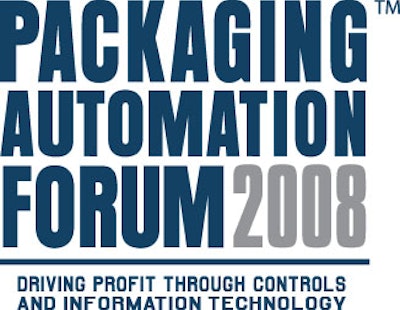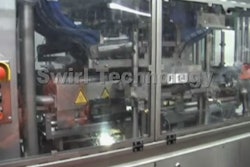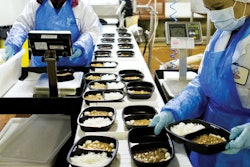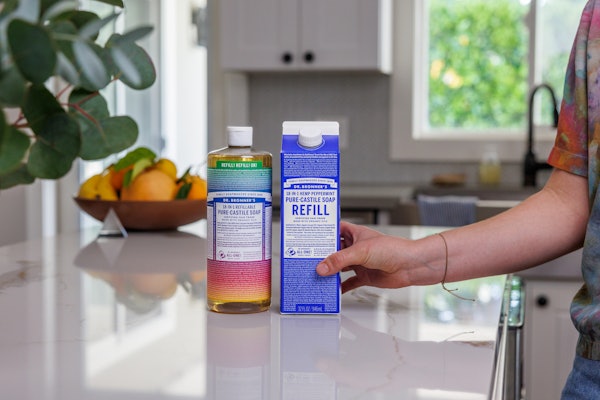
Keynoter David Atherton, director of supply chain engineering and quality in the hair group at Unilever America, opened the Packaging Automation Forum with a look at how, over the last five years, Unilever has used technology to make its supply chain a value-added part of its overall business.
He began by noting that
• the world has become more intensely competitive than ever
• Unilever’s product portfolio is fundamentally some pretty routine stuff, like soap or shampoo of one kind or another
• consumers have grown increasingly sophisticated and fickle
• sustainable packaging has arrived in a big way
• retailers wield more power than ever
• commodity costs are skyrocketing thanks largely to the spike in oil prices
Operating in an environment shaped by such realities, how does a company like Unilever respond? By driving growth and containing spiraling costs. Atherton believes there are three keys to success where driving growth is concerned: excite the customer, offer the best price, and deliver the best level of service.
“Traditionally, manufacturers have said to themselves, ‘I’ve got to be the best at one of these three things and I’ve got to be pretty darned good at the other two,’” said Atherton. “The problem with today’s environment is that we’re being asked to be the best at all three.”
Supply chain efficiency, said Atherton, plays a key role in Unilever’s efforts to thrive and prosper in these challenging times. “We have to take the demand signal from our multiple [retail] customers and drive it back not only into our planning systems but also to our suppliers, our manufacturing locations, our internal distribution systems, and finally to our customers’ Distribution Centers to replenish that store demand,” Atherton explained to the PAF audience. “Keep in mind, too, that the complexity of this task has grown enormously as the number and variety of items we manufacture have expanded significantly.”
Technology has played an important role as Unilever’s supply chain model has evolved. Underpinning the firm’s method of incorporating new technology is what Atherton described as “a commitment to converge the asset base.” Essentially it’s a matter of minimizing the amount of vendors involved.
“In converging our asset base, there are three things we’ve done,” said Atherton. “First, we’ve identified strategic OEM partners for primary packaging machinery. We haven’t been as worried about secondary packaging equipment in terms of trying to harmonize or standardize. But with machines having to do with how we handle the bottle or cap, we’ve tried to identify who we believe provides the best technical solution, the best level of service, and the right reach for supporting our manufacturing network in the Americas.
“We’ve also standardized on a preferred controls technology provider that we expect our packaging machinery OEMs to work with. We recognize that this can have minuses as well as pluses. Internally, we see it as a plus when our operators or mechanics are always seeing the same controller. But we ask ourselves if specifying a technology provider somehow limits us from a technology standpoint. If the controls platform we specify isn’t the OEM’s platform of preference, are we saddling ourselves where machine performance is concerned?” Atherton freely acknowledged that he doesn’t have a good answer to this question.
The third thing Unilever has done to converge its asset base is to establish long-term relationships with integrators, builders, and other service providers.
Flexibility, reliability, and measurability are all crucial in the way Unilever applies technology to supply chain excellence, said Atherton. So is information.
“Timely information is what’s important, not data,” Atherton pointed out. “I can do things with information. I can’t do that with data. And remember that peoples’ information needs differ according to where they are in the supply chain. The operator’s or mechanic’s information needs are different than the supply chain planner’s.”
And what about real-time data? With more and more integrators and analysts insisting that it’s essential in today’s manufacturing scene, what is Unilever’s opinion of it?
“I’d love to have real-time information, but right now I don’t really need it for the supply chain to function,” said Atherton. “I probably need information weekly. We’re not sending Wal-Mart an order every 20 minutes. We’re replenishing their distribution centers weekly. So that’s the information cycle time I need in my manufacturing operation.”
Atherton acknowledged that OEE (Overall Equipment Efficiency) is a yardstick that needs to be used. But he’s leery of it at the same time.
“I don’t see it as the be all and end all when we talk about measuring efficiency,” said Atherton. “I think it can drive the wrong behaviors.”
Rather than relying too heavily on things like OEE to measure how effective technology upgrades at Unilever have been in the past five years, Atherton prefers to look at gains made in safety, righ-first-time manufacture, reduced changeover times, labor output per employee, reduced inventory, and speed to market. In all six areas, dramatic improvements have been made over the past five years.
“If we lived in a static world,” said Atherton, “these improvements wouldn’t be all that special. But we’ve been able to make these gains even as we watched our product portfolio skyrocket in number and complexity.”
Atherton closed his remarks with these observations and recommendations:
• There’s good complexity and bad complexity. Good complexity drives growth, and bad complexity drives cost.
• Encourage collaboration, including collaboration among packaging machinery OEMs.
• Mandate standardization within your own manufacturing operations; don’t let a certain site sing the “we’re a special exception” song.
• Identify outcomes and measure them; and don’t measure inputs, measure outputs.
• Eliminate unfocused improvement.
“I’m not saying by any stretch of the imagination that we’ve been perfect as we’ve applied technology to improving our supply chain over the past five years,” Atherton said by way of concluding. “We’ve made some mistakes. We’ve underestimated and we continue to underestimate the learning curve of our workforce, our engineers, and our managers. And I think suppliers continue to overestimate their ability to support us. And to make all of this even more challenging, we now have to begin thinking about a supply chain in a world where oil may soon cost $200 per barrel, where the sustainable packaging agenda is front and center, and where the skills base is steadily eroding. That last item has me really worried. We need to revitalize our workforce, including managers, engineers, technicians, and operators. It seems to me that anyone who deals with technology needs a different skill set than they have today, including me.”
Packaging as an integrated process
Later on in the morning half of the PAF, Mark Hughes, automation consultant at Eli Lilly and Co., delivered a presentation called “Packaging as an integrated process (not just a line of connected machines).”
Hughes echoed Atherton in emphasizing how absolutely essential supply chain resiliency and flexibility are to a company that faces the kind of global competition that a prescription drug maker like Lilly faces. The firm must be operationally agile enough to scale capacity according to changing market demands. A great help are arrangements with firms that contract manufacture and package. Another strategy is to keep the making and packaging of newly developed drugs in a Lilly facility and outsource the making and packaging of a drug that is mature. This frees up capacity for the next drug the firm plans to generate.
“As a global entity, part of what enhances our agility are common business processes,” Hughes told his audience. “Can I talk to someone about how to make a product in Mexico that they’re also making in Puerto Rico or Spain? To make such conversatons possible, we’ve devoted considerable time to standardizing our business processes and then enabling those standard processes with technology.
“For a long time our status quo around equipment purchasing was to buy the best machine to do whatever particular task we wanted. The best cartoner, labeler, case packer, palletizer, and so on. But the equipment that is considered ‘best’ changes from site to site, so in 13 core sites, even where the exact same product is being packaged to the same specifications, we might have been doing it 13 different ways. This site-based delivery of solutions that are unique problem-solving exercises every single time no longer scales for us. We can’t afford this model any longer. Cost pressures in the pharmaceutical industry are starting to look like cost pressures in other businesses. We are being forced to be much more efficient.”
Hughes acknowledged that when it comes to packaging proficiency, Lilly is probably a bit behind today’s leading Consumer Packaged Goods (CPG) companies. But that’s primarily because earnings in the pharmaceutical industry come from better molecules and better chemistry. Consequently, Lilly has invested relatively little in the packaging side of its business and far more in chemistry.
“We are, however, very integrated from an information standpoint,” said Hughes. “We’ve adopted the ISA engineering standard S95, which identifies appropriate layers of functionality in your manufacturing information architecture, where that functionality ought to reside, and why it should reside there. Equipment, for us, plugs in at levels zero and one [see Figure 1]. We not only standardize on functionality, we’ve standardized on business partners that deliver that functionality for us.
“For example, on the bulk side of our business, we’re standardized on our SCADA and control system with Emerson’s Delta V platform and product. By standardizing this way, we migrate with Emerson over time as they develop their technology. It means we’re partnered at a business relationship level, not a technology platform level, because if you do that, you will chase technology platforms forever. We assume Emerson knows what they’re doing in the controls space on the bulk side, and as they move the platform as it serves their business, we’ll stay aligned with them.
“On the packaging side, we have a similar strategy in that we’ve standardized on a platform there as well. All of our sites, globally, have this same manufacturing architecture as their goal. I can’t point to a single site that has been able to implement this goal completely, nor do I ever expect to. But it is a strategy we are looking for.”
Hughes believes the pharmaceutical industry has been very good at dealing with force, mass, and energy. In another words, “We can move the packs as fast as you want, we can print on them, we can get them palletized, we can get them out there. What we’ve struggled with, and continue to struggle with, is how to manage the right appropriate information to make the decisions I need to make about the packaging line. If I want information about Line 13, I have no way of getting it unless I go out to that line and monitor its performance.”
This needs to be addressed, said Hughes, because from a business perspective, the important question is not “How is the labeler running” but rather “How is Line 13 running?”
“My reason for emphasizing this is that I don’t deliver machines to the organization. Rather, I install lines that deliver capability to the organization. Individual machines are only important to me as they fit into a line. And from an integrated architecture standpoint, those same machines are only valuable to me as they plug into my integrated information architecture. My plea to the builders of packaging machinery is that I need your systems to be integratable into my systems and into my architecture. I don’t need you to figure out how to put a data historian on your machine and give me reports. That actually makes my job much harder. If your machine comes completely self-sufficient, has an OEE package on it, and generates productivity reports, I now have to integrate that complexity into my overarching system, and so you have honestly done me no favors. I understand the drive to do that, to be a standalone piece of equipment. But that piece of equipment is part of a line. If you’re selling me the entire line, knock yourself out. But if you’re providing a labeler or cartoner and there’s four other machines in the line beside them, my responsibility is the entire line. Sub-optimizing any individual piece of equipment in that line only complicates my life.”
The final portion of Hughes’ presentation addressed the pharma industry’s need to uniquely serialize every saleable unit so that it can be readily known when and where it was made, who made it, and who has handled it throughout the distribution chain. The requirement to have such serialization in place is driven largely by the California Board of pharmacy, though other states as well as players at the federal level are also making noise.
“The problem I see developing as serialization strategies develop is this: we have too many unique pieces of equipment with unique inspection criteria and unique reject stations on 55 lines across the country,” says Hughes. “In printing on a carton, I have 55 ways of doing it and 55 ways of rejecting cartons that need to be rejected. When I get to the case level, I have 55 different ways of making my cases, and at palletizing I may have another 55 different pieces of equipment. That requires too much time spent on unique integrations when what’s really called for is a global solution, where I develop a standard approach to managing these serial numbers, distributing them, and printing them. Then, as technology or legislation changes, I could upgrade my global solution rather than having to modify a multitude of unique solutions.”
What Hughes asks packaging machinery builders to do is to think about unique serialization information as information that’s owned not just by their machine, but by the enterprise buying the machine.
“As serialization rolls toward you from customers in the pharmaceutical industry, I implore you not to solve their serialization problems uniquely or in a machine-centric way,” said Hughes. “Don’t be overly helpful when it comes to that cartoner, for example. A global solution is what’s called for.”
Time for mechatronics
Also on the PAF 2008 program was Rob Aleksa, corporate machine control section head at Procter & Gamble. His presentation: “Driving packaging equipment capability & Performance—the Mechatronic Method.”
While Aleksa’s remarks were aimed at a broad audience, he admitted that it was the packaging machinery OEM that he had specifically in mind. “I’d like to have the OEMs better understand the dynamics of the equipment system,” said Aleksa. “This will permit them to build robust, reliable, and optimally designed machines. It’s not that there aren’t good packaging machines out there, but few are optimally designed.”
Part of the problem springs from the difference between machines of today and machines of yesterday.
“We used to buy packaging equipment that was completely mechanically designed. It was a world where cam shaft synchronization was everything. We’re now moving to machines that are more servo based, where mechanical systems have given way to electronics. So now it’s not uncommon to have packaging machines with up to 40 axes of motion. The complexity of such a machine is considerably greater. To build this equipment, you have to think a little bit differently than you did in the past.”
The shortcoming right now, in Aleksa’s view, is that equipment dynamics are falling between the cracks and machine builders are taking too much of a silo approach. Neither the controls folks nor the mechanicals folks have a comprehensive view of total equipment dynamics. The two camps need to study jointly the speeds a machine will be required to master, the load the machine will be expected to lift or carry, the ladder logic requirements that will govern it, and the motion tools and software by which it will abide.
“The solution here is the mechatronics methodology,” said Aleksa. “It’s focused on machine dynamics as a multidisciplinary effort across the disciplines of mechanical engineering, electrical engineering, and modeling analysis. In some ways it’s a return to basics. It’s applying science to machine dynamics. It’s using analysis to improve the machine design, the performance of existing machines, and the choices you make around the control system, the control algorithm, and the mechanical components you are going to put into a system.”
If a machine designer doesn’t pay attention to machine dynamics, problems are inevitable. By way of an example, Aleksa described a bag feeding system purchased by a P&G business unit. The machine builder had supplied P&G with similar equipment in the past, but for this particular machine the builder was asked to use servos instead of a frequency drive system. The machine passed the Factory Acceptance Test just fine, but after only a few weeks on the P&G plant floor, the operating speed of the machine had to be greatly reduced. The machine was basically shaking itself to death because the gear boxes and couplings that had served admirably in a bagger operating on a frequency-drive basis were not suitable for a machine that substituted servos for frequency drives.
“If the OEM had known even the basics of the system’s dynamics, and if they had done the proper modeling analysis, they would have realized that they had this high-performance, high-end, servo-based system connected to the load basically through a bunch of springs,” said Aleksa.
Aleksa concluded his presentation by observing that packaging machinery designers of the future would have a much better understanding of mechatronics if our educational system were re-tooled.
“To build good packaging machinery today you need a solid foundation in both electrical and mechanical engineering,” said Aleksa. “That’s the only way to develop the mechatronics capability that I think is so important going forward.” Unfortunately, our educational system doesn’t do a good job of equipping students with this multidisciplinary engineering sensibility. “We need to change that,” said Aleksa.






















